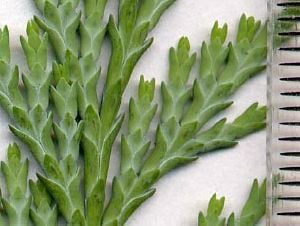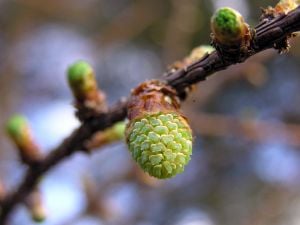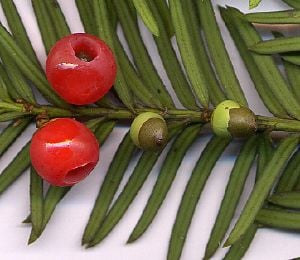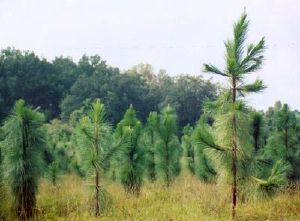Conifer
| Conifer | ||||||
|---|---|---|---|---|---|---|
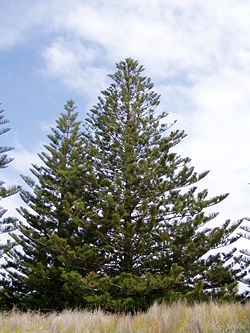 {{{caption}}} | ||||||
| Scientific classification | ||||||
| ||||||
| Orders & Families | ||||||
|
Cordaitales † |
The conifers, division Pinophyta, also known as division Coniferae, are one of 13 or 14 division level taxa within the plant kingdom. They are cone-bearing seed plants with vascular tissue; all living conifers are woody plants, the great majority being trees with just a few being shrubs. Typical examples of conifers include cedars, cypresses, firs, junipers, pines, redwoods, spruces, and yews. Conifers can be found growing naturally in almost all parts of the world, and are frequently dominant plants in their habitats.
Conifers are of immense economic value, primarily for timber and paper production.
Taxonomy
Conifers are gymnosperms, along with three much smaller plant divisions: Ginkgophyta (the ginkgo tree), Cycadophyta (the cycads)), and Gnetophyta (the genuses Gnetum, Ephedra, and Welwitschia). This means that they bear their seeds "naked", not covered by an ovary which in angiosperms (which include most flowering plants) develops into a fruit or seed covering.
The division Pinophyta consists of just one class, Pinopsida. This includes four orders, three of which (Cordaitales, Vojnovskyales, Voltziales) are long extinct and known only through fossils). All living conifers are members of the order Pinales, which is generally divided into seven families.
Morphology
All living conifers are woody plants, and most are trees, the majority having monopodial growth form (a single, straight trunk with side branches) with strong apical dominance (the truck is dominant over the branches).
The size of mature conifers varies from less than one metre, to over 100 metres. The world's tallest, largest, thickest and oldest living things are all conifers. The tallest is a Coast Redwood (Sequoia sempervirens), with a height of 112.83 metres. The largest is a Giant Sequoia (Sequoiadendron giganteum), with a volume 1486.9 cubic metres. The thickest, or tree with the greatest trunk diameter, is a Montezuma Cypress (Taxodium mucronatum), 11.42 metres in diameter. The oldest is a Great Basin Bristlecone Pine (Pinus longaeva), 4,700 years old.
Foliage
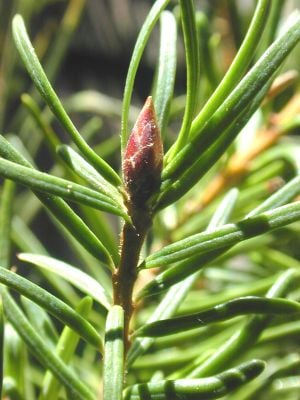
The leaves of many conifers are long, thin and needle-like, but others, including most of the Cupressaceae and some of the Podocarpaceae, have flat, triangular scale-like leaves. Some, notably Agathis in Araucariaceae and Nageia in Podocarpaceae, have broad, flat strap-shaped leaves. In the majority of conifers, the leaves are arranged spirally. In many species the leaf bases are twisted to present the leaves in a flat plane for maximum light capture (see e.g. photo of Grand Fir Abies grandis). Leaf size varies from 2 mm in many scale-leaved species, up to 400 mm long in the needles of some pines (e.g. Apache Pine Pinus engelmannii). The stomata are in lines or patches on the leaves, and can be closed when it is very dry or cold. The leaves are often dark green in colour which may help absorb a maximum of energy from weak sunshine at high latitudes or under forest canopy shade. Conifers from hotter areas with high sunlight levels (e.g. Turkish Pine Pinus brutia) often have yellower-green leaves, while others (e.g. Blue Spruce Picea pungens) have a very strong glaucous wax bloom to reflect ultraviolet light. In the great majority of genera the leaves are evergreen, usually remaining on the plant for several (2-40) years before falling, but five genera (Larix, Pseudolarix, Glyptostrobus, Metasequoia and Taxodium) are deciduous, shedding the leaves in autumn and leafless through the winter. The seedlings of many conifers, including most of the Cupressaceae, and Pinus in Pinaceae, have a distinct juvenile foliage period where the leaves are different, often markedly so, from the typical adult leaves.
Reproduction
See conifer cones for a more detailed discussion.
Most conifers are monoecious, but some are subdioecious or dioecious; all are wind-pollinated. Conifer seeds develop inside a protective cone called a strobilus (or, very loosely, "pine cones", which technically occur only on pines, not other conifers!). The cones take from four months to three years to reach maturity, and vary in size from 2 mm to 600 mm long. In Pinaceae, Araucariaceae, Sciadopityaceae and most Cupressaceae, the cones are woody, and when mature the scales usually spread open allowing the seeds to fall out and be dispersed by the wind. In some (e.g. firs and cedars), the cones disintegrate to release the seeds, and in others (e.g. the pines that produce pine nuts) the nut-like seeds are dispersed by birds (mainly nutcrackers and jays) which break up the specially adapted softer cones. Ripe cones may remain on the plant for a varied amount of time before falling to the ground; in some fire-adapted pines, the seeds may be stored in closed cones for up to 60-80 years, being released only when a fire kills the parent tree.
In the families Podocarpaceae, Cephalotaxaceae, Taxaceae, and one Cupressaceae genus (Juniperus), the scales are soft, fleshy, sweet and brightly coloured, and are eaten by fruit-eating birds, which then pass the seeds in their droppings. These fleshy scales are (except in Juniperus) known as arils. In some of these conifers (e.g. most Podocarpaceae), the cone consists of several fused scales, while in others (e.g. Taxaceae), the cone is reduced to just one seed scale or (e.g. Cephalotaxaceae) the several scales of a cone develop into individual arils, giving the appearance of a cluster of berries.
The male cones have structures called microsporangia which produce yellowish pollen. Pollen is released and carried by the wind to female cones. Pollen grains from living pinophyte species produce pollen tubes, much like those of angiosperms. When a pollen grain lands near a female gametophyte, it undergoes meiosis and fertilizes the female gametophyte. The resulting zygote develops into an embryo, which along with its surrounding integument, becomes a seed. Eventually the seed may fall to the ground and, if conditions permit, grows into a new plant.
In forestry, the terminology of flowering plants has commonly though inaccurately been applied to cone-bearing trees as well. The male cone and unfertilized female cone are called "male flower" and "female flower", respectively. After fertilization, the female cone is termed "fruit", which undergoes "ripening" (maturation).
Life cycle
- To fertilize the ovum, the male cone releases pollen that is carried on the wind to the female cone.
- A fertilized female gamete (called a zygote) develops into an embryo.
- Along with integument cells surrounding the embryo, a seed develops containing the embryo.
- Mature seed drops out of cone onto the ground.
- Seed germinates and seedling grows into a mature plant.
- When mature, the adult plant produces cones.
Other facts
Although the total number of species is relatively small, conifers are of immense ecological importance. They are the dominant plants over huge areas of land, most notably the boreal forests of the northern hemisphere, but also in similar cool climates in mountains further south.
Many conifers have distinctly scented resin, secreted to protect the tree against insect infestation and fungal infection of wounds. Fossilised resin hardens into amber.
ReferencesISBN links support NWE through referral fees
- Dallimore, W. & Jackson, A.B. revised by Harrison, S.G., 1967, A Handbook of Coniferae and Ginkgoaceae, New York : St. Martin's Press
- Earle, C.J., 2006, The Gymnosperm Database, Website[1]
- Hartzell, H., 1991, The Yew Tree, Eugene, Oregon : Hulogosi
- Lanner, R.M., 1999, Conifers of California,Los Alivos, California : Cachuma Press ISBN 0962850535
- Pielou, E.C., 1988, The World of Northern Evergreens, Ithica, New York : Cornell University ISBN 0801421160
Credits
New World Encyclopedia writers and editors rewrote and completed the Wikipedia article in accordance with New World Encyclopedia standards. This article abides by terms of the Creative Commons CC-by-sa 3.0 License (CC-by-sa), which may be used and disseminated with proper attribution. Credit is due under the terms of this license that can reference both the New World Encyclopedia contributors and the selfless volunteer contributors of the Wikimedia Foundation. To cite this article click here for a list of acceptable citing formats.The history of earlier contributions by wikipedians is accessible to researchers here:
The history of this article since it was imported to New World Encyclopedia:
Note: Some restrictions may apply to use of individual images which are separately licensed.
